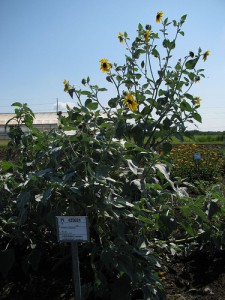- Avenues to meet food security. The role of agronomy on solving complexity in food production and resource use. Wait, what, it’s not all about the breeding?
- Population studies of native grass-endophyte symbioses provide clues for the roles of host jumps and hybridization in driving their evolution. Wait, what, we have to conserve these things too now?
- Morphological diversity in breadfruit (Artocarpus, Moraceae): insights into domestication, conservation, and cultivar identification. Cool, we now have a multi-access Lucid key to help us recognize varieties.
- Geographical variation of foxtail millet, Setaria italica (L.) P. Beauv. based on rDNA PCR–RFLP. Geographic differentiation, centre in East Asia, evidence of migration, yada yada.
- Within-genotype epigenetic variation enables broad niche width in a flower living yeast. Wait, what, now we have to document the epigenome too?
- Phylogeography of Asian wild rice, Oryza rufipogon: a genome-wide view. Fancy markers come through where lesser breeds caused confusion. Two groups, clinally arranged, with the China-Indochina group close to indica, neither close to japonica. So one, Chinese, domestication event, yada yada.
Talking tomato Today
Dr Sandra Knapp of the Botany Department of the Natural History Museum in London was interviewed by the BBC’s Today Programme this morning about the tomato genome, which of course has been all over the news lately. You can hear her 54:20 minutes in, or, if that doesn’t work, here. Particularly cool that she squeezes in a mention of the wild relative that was also sequenced.
Nibbles: GIBF, Identifiers, Farming animals, Geomedicine, Seed saving, Seeds of Success, CWRs, CORA 2012, Sourdough culture bank, Phenology, Wild Coffea, Cassava conference, Condiments, Gulf truffles, Cashew nut, Home gardens, Tea, Bacterial diversity
- GIBF taxonomy is broken. We’re doomed. No, but it can be fixed. Phew.
- Maybe start with a unique identifier for taxonomists? Followed by one for genebank accessions… Yeah. Right.
- Domesticating animals won’t save them. And more on the commodification of wildlife. Is that even a word?
- Geomedicine is here. Can geonutrition be far behind? We’re going to need better maps, though.
- Saving heirlooms, one bright student at a time.
- “Botanists Make Much Use of Time.” If you can get beyond the title, there’s another, quite different, but again quite nice, seed saving story on page 3.
- “Why aren’t these plants the poster children [for plant conservation]?” You tell me.
- Or, instead of doing something about it, as above, we could have a week of Collective Rice Action 2012.
- You can park your sourdough here, sir.
- How Thoreau is helping boffins monitor phenology. But there’s another way too.
- “She drinks coffee. She farms coffee. She studies coffee.” Wild coffee.
- Massive meet on the Rambo Root. Very soon, in Uganda.
- Ketchup is from China? Riiiight. Whatever, who cares, we have the genome!
- And in other news, there are truffles in Qatar. But maybe not for long.
- The weirdness of cashews.
- The normalcy of home gardens as a source of food security — in Indonesia.
- Ok, then, the weirdness of oolong tea.
- Aha, gotcha, the normalcy of office bacterial floras! Eh? No, wait…
Sunflower guru bags medal
Plant scientist Loren Rieseberg awarded Linnean Society's Darwin-Wallace medal #linneansociety
— Sandra Knapp (@SandyKnapp) May 24, 2012
 I don’t see it on its website yet, but the Linnean Society of London has just awarded the prestigious Darwin-Wallace Medal to Loren Rieseberg, according to Twitter traffic. Dr Riesberg is an expert on sunflower genetics and evolution, and has done much pioneering work on the wild relatives. As luck would have it, I interviewed him recently about his work, and you can listen to the result here. Congratulations to Loren.
I don’t see it on its website yet, but the Linnean Society of London has just awarded the prestigious Darwin-Wallace Medal to Loren Rieseberg, according to Twitter traffic. Dr Riesberg is an expert on sunflower genetics and evolution, and has done much pioneering work on the wild relatives. As luck would have it, I interviewed him recently about his work, and you can listen to the result here. Congratulations to Loren.
Biodiversity informatics information
Nice idea for the imminent Global Biodiversity Informatics Conference (2-4 July 2012, Copenhagen, Denmark) to have a Mendeley group. You know about our Brainfood group, right?
LATER: Sounds like they might have quite a lot to talk about…